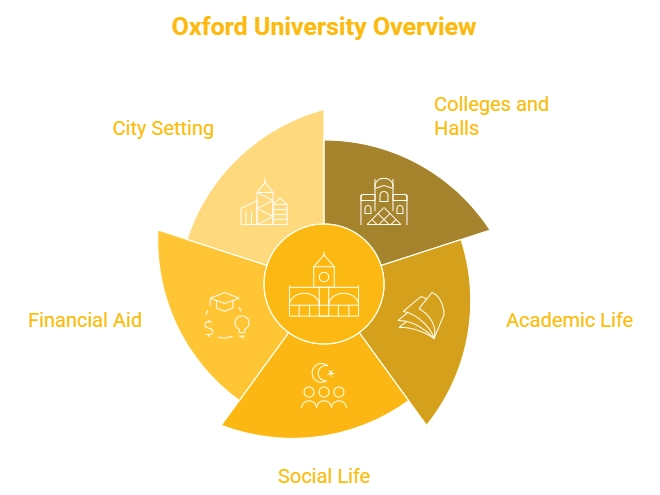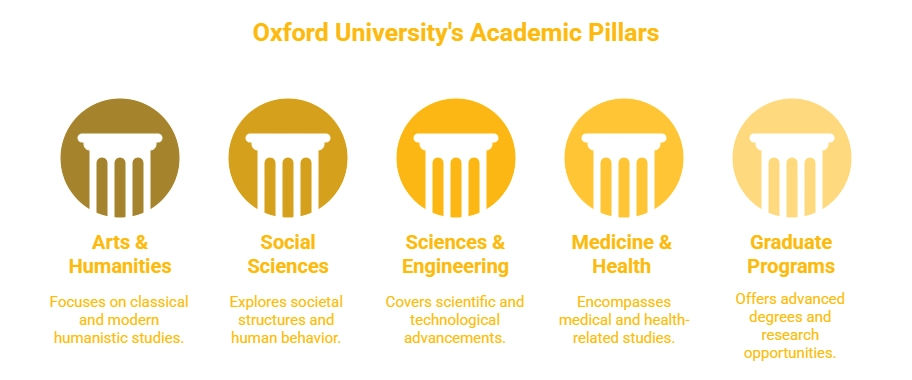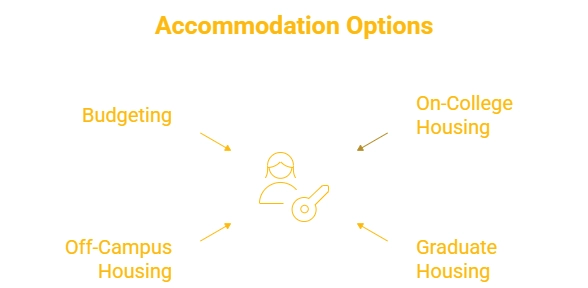Study in UK
Don't know what to do?
Get Free Counseling
Why Study at Oxford University?
Selecting a university involves considering its prestige, how it can help your career, and the overall student life it offers. Oxford provides top-notch teaching and research, a long-standing college system, and a good history of getting graduates into jobs. It often ranks high globally, draws students internationally, and gives great access to resources like libraries, museums, research centres, and industry connections.
- Student Population (2024): There are 26,595 students total, with about 12,375 undergraduates and 13,650 graduate students.
- Admissions (Undergraduate 2024): Roughly 3,300 places were open for undergraduates, and there were 23,000 applicants. This means the acceptance rate was about 14.3%.
- Reputation and Research: Oxford is known worldwide (ranking highly in QS and THE rankings) and has extensive research activities with excellent faculty and labs.
Why This Information Matters for UK Applicants:
- Selective Admissions: Getting into Oxford is tough. You need good grades and must show potential in your chosen subject.
- Worldwide Recognition: An Oxford degree is well-regarded by employers and graduate programs everywhere.
- Support and Resources: The college system offers focused teaching and support, and the university provides resources for research and career help.
Oxford University World QS Ranking
Oxford is consistently one of the world’s top universities in global league tables. The QS World University Rankings for 2026 place Oxford 4th worldwide, based on its academic and employer standing, research influence, and international perspective.
Understanding Rankings:
Different ranking systems use different approaches. QS emphasizes academic and employer surveys plus citations per faculty member. THE (Times Higher Education) puts more weight on teaching, research, citations, and international factors. Oxford does well in many areas, which explains its consistent high ranking in most major tables.
Advice for Applicants:
Rankings show worldwide recognition, but applicants should also consider a department's standing, fit within a college, and teaching style when picking a course. Focus on subject-specific rankings, not just the overall rank, when deciding what to study.

Oxford University Acceptance Rate
Oxford admissions are competitive, and the standards change based on the course.
- In 2024, about 23,000 people applied for roughly 3,300 undergraduate spots, leading to an overall undergraduate acceptance rate of 14.3%.
Course-Level Differences
- Acceptance rates change a lot by subject. Some courses, like Medicine and Economics & Management, are very selective, while others are easier to get into. Past data shows that offer/acceptance rates can be less than 10% or more than 40%, depending on demand and space. Applicants should see the subject pages for detailed stats on their chosen course.
How Oxford Evaluates Applicants
- Academic history: Predicted or achieved grades in A-levels, IB, or similar. Successful applicants usually have grades around A\*AA–AAA, but it depends on the course.
- Admissions tests and written assignments: Many courses need a written admissions test (BMAT, LNAT, MAT, PAT, etc.) or submitted written work.
- Interviews and background: Applicants who make the shortlist get an interview. A strong interview and proof of interest in the subject are very important.
- UK vs. international: The same academic rules apply, but they use qualification conversions for applicants from outside the UK.
Oxford University Campuses
Oxford is a collegiate university, not a multi-campus one. Its teaching and research are based in the city of Oxford, and the college system is key to the student experience.
Colleges and Halls: Oxford has 36 colleges, three societies, and four permanent private halls. Each college is self-governing and offers housing, tutorials, support, and social events. Students join both a college and the university.
Why colleges matter: Colleges host many tutorials (small-group teaching sessions). They influence your academic and social life and often offer financial aid and scholarships. Colleges differ in size, housing, facilities, and traditions. Many applicants state college choices, while others ask for open assignment.
City setting and facilities: Oxford has many libraries (like the Bodleian), museums (like the Ashmolean), research centers, and ties to industry and culture. It is close to London and Europe for internships, conferences, and trips.

Courses offered at Oxford University
Oxford has four divisions that provide different programs for graduates and undergraduates: Humanities, Mathematical, Physical & Life Sciences, Medical Sciences, and Social Sciences.
Typical undergraduate courses:
- Arts & Humanities: Classics, English, History, Modern Languages, Philosophy
- Social Sciences: Economics & Management, Politics, PPE (Philosophy, Politics & Economics), Sociology
- Sciences & Engineering: Computer Science, Engineering Science, Biology, Chemistry, Physics, Mathematics
- Medicine & Health: Medicine (pre-clinical & clinical), Biomedical Sciences
Graduate programs:
Master's degrees, research degrees, professional doctorates, and DPhils (PhDs) are offered in many subjects. A lot of departments have master's programs such as an MSc in Computer Science, or an MSc in Evidence-Based Social Intervention.

Things to know:
- Tutorial system: individualized teaching to grow independent thinking and strong academic guidance.
- Interdisciplinary research centres: many research institutes and centres that include multiple departments such as the Oxford Internet Institute, and the Oxford Martin School.
- Placement & work support: career services, college networks, and mentoring from past students for job opportunities after graduation.
Choosing a course:
Carefully read course pages to understand the structure, requirements such as a year abroad, how the course is graded, and admission test needs. If you can, go to open days and sample lectures.
Oxford University Fees and Scholarship
Here's a brief table showing typical fee ranges and major scholarship programs. Keep in mind that fees differ by course and are updated each year. Always check the Oxford course page for the most current information.
|
Student Group |
Typical Course Fees (per Year) |
Typical Living Costs (per Year) |
Major Scholarship Examples |
|
Home (UK) undergraduates |
£9,535 (2025/26 guidance; subject to government cap — check latest) |
£17,100–£24,420 (estimated living costs per year; colleges can reduce some costs) |
Oxford bursaries, college hardship funds |
|
Overseas (international) undergraduates |
£35,000–£58,000 (typical range depending on course — e.g., humanities at lower end; clinical and laboratory-intensive courses at higher end) |
£17,100–£24,420 (same living cost guidance applies) |
Oxford International Scholarships, Reach Oxford Scholarship |
|
Postgraduate (UK/home) |
£10,000–£45,000+ (wide range depending on master’s or research programme) |
£17,100–£24,420 (varies by course length and personal spending) |
Clarendon Scholarships (fully funded), UK Research Council funding |
|
Postgraduate (international) |
£20,000–£50,000+ (many master’s programmes fall between £25k–£45k) |
£17,100–£24,420 |
Clarendon Scholarships (fully funded), college scholarships, departmental studentships |
Oxford University Accommodation Options for International Students
Colleges are very involved in housing students, mostly first-year undergraduates.
On-college housing
• Most colleges make sure that first-year undergraduates have housing, often in college rooms with shared or private bathrooms. Colleges usually provide food or kitchens.
Graduate housing
• Many colleges also have rooms or apartments for graduate students, but it depends. The Graduate Housing Service and college websites have lists and waiting lists.
Off-campus housing
• There are private rentals and student housing all over the city. Prices change based on location and type (shared flat or studio). Plan for rent, council tax (if needed), utilities, and council deposits.
Budgeting
• Colleges sometimes lower the cost of meals, events, and facilities, which lowers living costs. Apply for college housing early and check the college housing pages for prices and contract lengths.

Oxford University Application Process
Here’s a guide for UK applicants, and international applicants from a UK point of view, for both undergraduate and graduate study.
Steps for Undergraduate Programs (standard route using UCAS and Oxford's process)
Step 1: Carefully read the course page for required subjects, admission tests (like BMAT, LNAT, MAT), and the typical A-level/IB grades needed.
Step 2: Sign up for tests early. Test dates vary, with some in the fall, so check when your test is.
Step 3: Oxford wants UCAS applications earlier than many UK universities. Check the specific date for the current year. Applications include your personal statement, predicted or achieved grades, and a reference.
Step 4: Some courses need writing samples or portfolios, such as English or History of Art. Follow the department's guidance closely.
Step 5: Applicants who make the shortlist get invited to interviews, either in person or online. Interviews check your subject knowledge, thinking, and potential, not just what you already know.
Step 6: Offers can depend on grades (like A\*AA) or be unconditional, based on your qualifications and situation. If you get an offer, use UCAS to accept, hold, or decline it.
Step 7: If you get a spot, apply for college housing and look into funding options like college support, central scholarships, and government loans if you can get them.
Steps for Graduate Programs (masters / DPhil)
Step 1: See department pages for research ideas, supervisor availability, and specific must-haves.
Step 2: Expect to need academic transcripts, a CV, a research idea (for research degrees), references, and proof of English if it's needed.
Step 3: Deadlines change based on the course and funding. Many Clarendon scholarship candidates must apply by the December/January deadline to get looked at automatically.
Step 4: Apply for college/department scholarships and outside funding as early as you can. Clarendon looks at eligible applicants on its own.
Step 5: If accepted, follow the university's directions for signing up, visa help for overseas students, and college placement.
Why Choose Y-Axis to Study at Oxford University?
- Professional Advice for UK Applicants: Tailored assistance for UK students submitting applications to universities in Europe.
- End-to-End Application Support: Everything under one roof, from choosing a university to applying for a visa.
- Scholarship Help: We assist you in locating and submitting applications for the top scholarships for which you qualify.
- Preparation and Review of Documents: Proper documentation is necessary to prevent application delays or rejections.
- Trusted by Thousands: More than 1 million customers have used Y-Axis to successfully complete their international education.
Testimonials
Frequently Asked Questions
